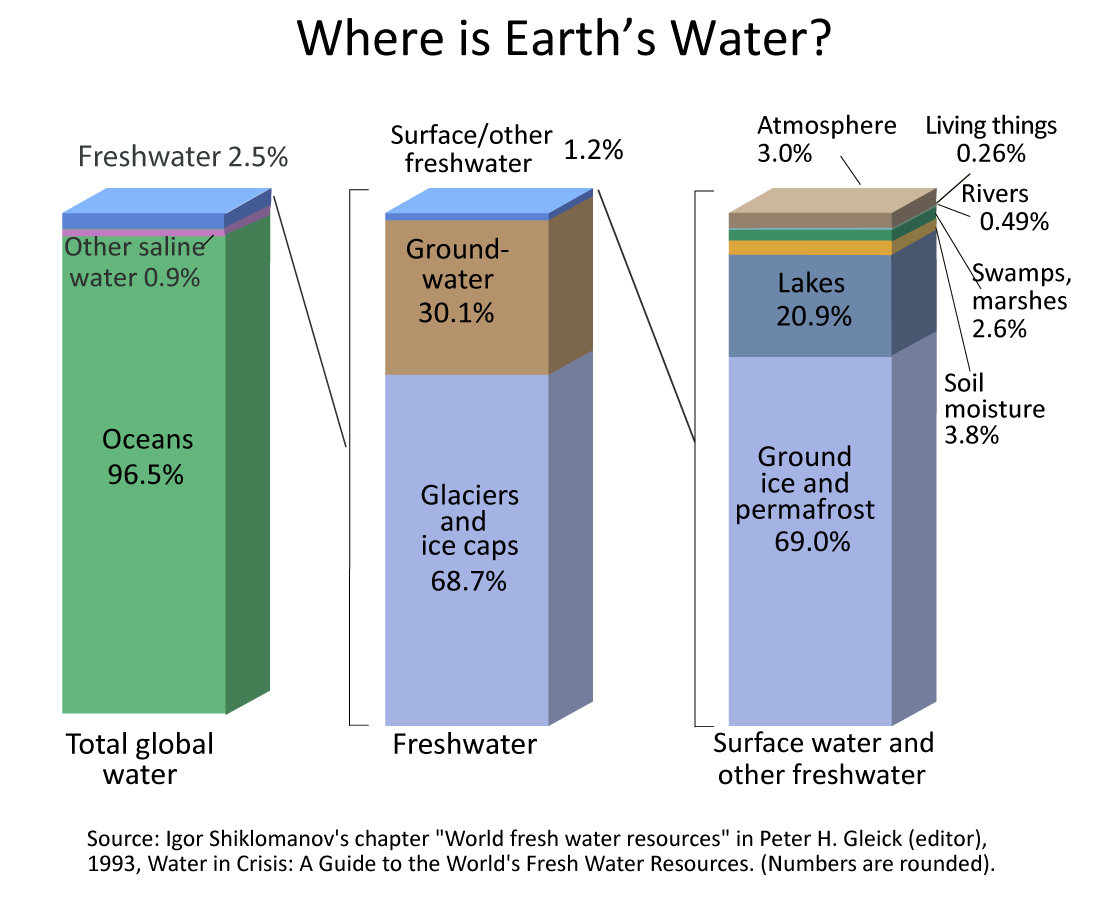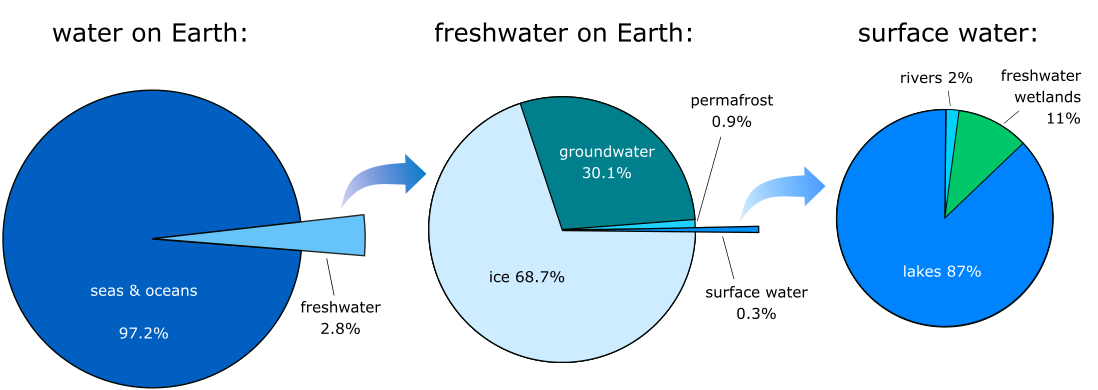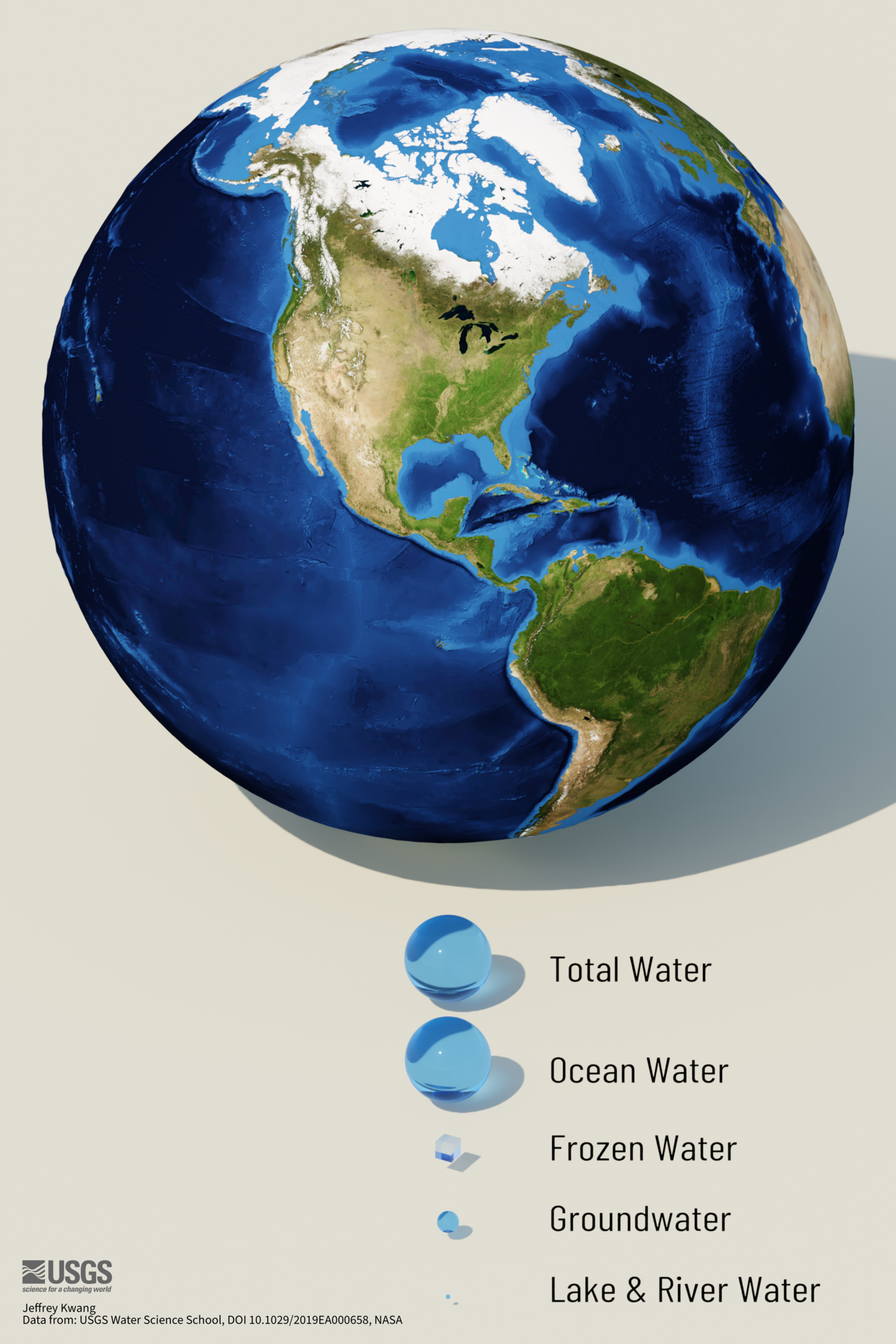IB Syllabus focus:
‘Oceans hold the vast majority; glaciers/ice and groundwater much less; surface water, atmosphere and organisms are tiny fractions—know relative sizes, not exact percentages.’
Water is essential for sustaining life and ecosystems. It exists in different stores across the planet, with vastly unequal proportions. Understanding their distribution supports environmental management.
Global Water Distribution
The hydrosphere encompasses all water on Earth, found in oceans, ice, groundwater, rivers, lakes, the atmosphere and within organisms. While water is abundant globally, its availability for human use is restricted because most of it is stored in inaccessible or saline reservoirs.
The Dominance of Oceans
The oceans contain the overwhelming majority of Earth’s water.

This chart compares the sizes of major global water stores, highlighting the dominance of the oceans and the much smaller freshwater and surface-water fractions. It visually reinforces the ranking of stores required by the syllabus. Note that numerical percentages are shown for context and exceed the IB requirement to know relative sizes only. Source.
Around 97% of the global water store is saline and unsuitable for direct human consumption. Oceans also regulate climate, drive the hydrological cycle, and act as major heat stores. Their size highlights why only a very small fraction of water is available as fresh and usable.
Cryosphere: Glaciers and Ice Caps
The cryosphere—glaciers, ice caps, and permanent snow—holds the second-largest water store. This frozen water is concentrated in Greenland and Antarctica, with smaller glaciers across mountain ranges. Although it represents the largest store of freshwater, it is locked away and not directly available for immediate use.
Cryosphere: The portions of Earth where water is stored as ice, including glaciers, ice caps, and snowfields.
Groundwater
Beneath Earth’s surface lies groundwater, a crucial store of freshwater. It represents a smaller fraction compared to glaciers but is far more accessible. Groundwater supports agriculture, drinking supplies, and ecosystems, although extraction must remain within sustainable limits to avoid aquifer depletion and land subsidence.
Groundwater: Water stored in porous soils and rock layers beneath Earth’s surface.
Surface Water
Surface water—rivers, streams, and lakes—accounts for an extremely small fraction of global water. Despite this, it is the most directly accessible store for human and ecosystem use. Its availability is unevenly distributed worldwide, leading to localised abundance or scarcity. Surface water plays a critical role in supporting biodiversity and human societies.

A simplified diagram showing Earth’s water stores by relative size, emphasising the small share of freshwater and an even smaller share of surface water. It aligns with the syllabus requirement to compare stores by magnitude. Some labels include percentage estimates that go beyond the syllabus’ focus on relative scale only. Source.
Atmospheric Water
The atmosphere contains only a tiny fraction of Earth’s water in the form of vapour and clouds. Despite its small size, it is crucial in regulating weather and climate patterns. The atmosphere is highly dynamic, moving water rapidly through the processes of evaporation, condensation, and precipitation.
Biological Water
Living organisms store a minute amount of water within their tissues. While insignificant in global terms, it is vital for sustaining life. Plants, through transpiration, also contribute to atmospheric water and the broader hydrological cycle.
Relative Proportions of Water Stores
To understand relative proportions, it is useful to rank stores from largest to smallest:
Oceans – Vast majority of global water (about 97%).
Glaciers/Ice caps – Largest freshwater store, though locked in ice.
Groundwater – Significant freshwater source, often tapped for human use.
Surface water – Very small, yet essential for daily needs.
Atmosphere – A tiny fraction, but dynamically important.
Organisms – Negligible on the global scale, but vital for life.
IB students should focus on relative scale comparisons, not memorising exact percentages. For example, oceans are vastly greater than glaciers, and glaciers outweigh groundwater, while surface water, atmosphere, and organisms represent minuscule proportions.

Scaled spheres depict total water and the principal stores (ocean, ice and glaciers, groundwater, lakes and rivers), making relative magnitudes immediately clear. This complements the syllabus emphasis on ranking stores by size. Labels include quantitative figures that are informative but extend beyond the syllabus requirement. Source.
Importance for Environmental Systems and Societies
Understanding water stores has implications for both ecological balance and human sustainability:
Reliance on groundwater and surface water for drinking and agriculture makes them highly vulnerable to overuse and contamination.
Climate change impacts the cryosphere, with melting glaciers contributing to sea-level rise and altering global water availability.
The small size of accessible stores highlights the challenge of ensuring water security in many regions.
Human Implications
The uneven distribution of accessible water stores explains global water scarcity. Regions with limited surface water or depleted groundwater face stress, while others may experience abundance. Awareness of relative proportions is essential for water resource management and planning.
Key Points to Remember
The ocean store dominates the global hydrosphere.
Freshwater is scarce, mostly locked in ice or underground.
Surface and atmospheric water are tiny fractions but vital in ecological and societal contexts.
Focus on relative proportions, not precise numerical values, as required by the IB syllabus.
FAQ
Relative proportions highlight the dramatic differences between major stores, such as oceans versus surface water, without overwhelming students with memorisation. The IB syllabus emphasises conceptual understanding over exact figures.
Climate change alters store sizes by accelerating glacier and ice melt, increasing atmospheric moisture, and shifting groundwater recharge patterns. These changes influence long-term water security and ecosystem stability.
They contain most of Earth’s freshwater, but the majority is frozen and unavailable for direct human use. Melting glaciers release water but cause sea-level rise rather than increasing usable freshwater supply.
Organisms regulate local hydrological processes through:
Transpiration, releasing water vapour into the atmosphere.
Storing water in tissues to support ecosystems.
Although globally tiny, this store links biological activity to the wider water cycle.
Groundwater appears abundant but recharges slowly. Over-extraction leads to aquifer depletion, land subsidence, and reduced surface water flows, threatening long-term availability for human and ecological use.
Practice Questions
Question 1 (2 marks)
Identify the two largest global water stores and state whether each contains fresh or saline water.
Mark scheme:
Oceans identified as the largest store (1 mark)
Correctly stated as containing saline water (1 mark)
Glaciers/ice caps identified as the second-largest store (1 mark)
Correctly stated as containing freshwater (1 mark)
Maximum 2 marks — award any two correct points.
Question 2 (5 marks)
Explain the importance of understanding the relative proportions of global water stores for human water management and sustainability.
Mark scheme:
Recognition that most of Earth’s water is stored in oceans and is saline, therefore unavailable for direct human use (1 mark)
Explanation that the majority of freshwater is locked in glaciers/ice caps and is largely inaccessible (1 mark)
Identification that groundwater, though smaller than glaciers, is highly significant as a usable freshwater source (1 mark)
Recognition that surface water is a tiny fraction but the most directly accessible for human societies (1 mark)
Clear link made to the need for sustainable management of groundwater and surface water due to their limited proportion and vulnerability to overuse/contamination (1 mark)
Maximum 5 marks — answers must address both the relative proportions and their implications for management to achieve full marks.

